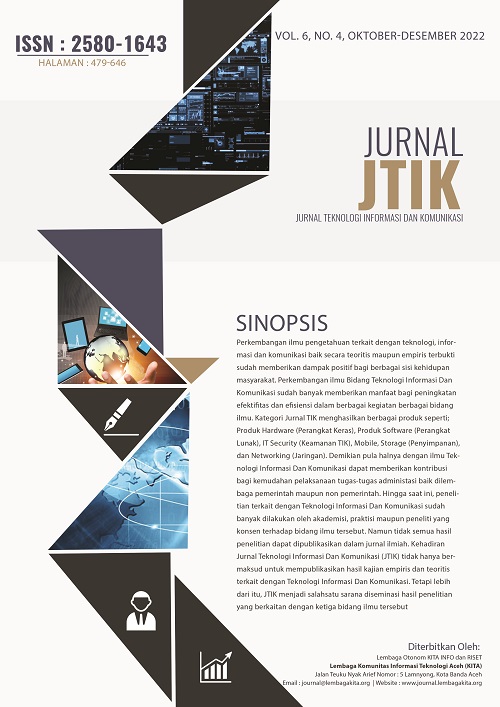Clustering Daerah Penyebaran Covid-19 di Indonesia Menggunakan Algoritma K-Medoids
Main Article Content
Abstract
The year 2019 was the beginning of the outbreak of a disease that hit the world today called the Covid-19 Virus. The virus originated from Wuhan and is now designated as a pandemic. The main problem raised in this study is how to determine the spread of covid-19 in Indonesia based on provincial data. Because there are several areas that have high prevalence cases, it is necessary to improve health services and protocols in these areas compared to areas with rather low distribution areas. So that in this study a clustering method is needed to be able to classify data on the spread of COVID-19 in Indonesia. The algorithm used for clustering is the K-Medoids algorithm. Based on the results of the research conducted, the K-Medoids Method is able to group the Covid 19 Spreading Areas in Indonesia.
Downloads
Article Details

This work is licensed under a Creative Commons Attribution-NonCommercial 4.0 International License.
The Authors submitting a manuscript do so on the understanding that if accepted for publication, copyright of the article shall be assigned to JTIK journal and Research Division, KITA Institute as the publisher of the journal. Copyright encompasses rights to reproduce and deliver the article in all form and media, including reprints, photographs, microfilms, and any other similar reproductions, as well as translations.
JTIK journal and Research Division, KITA Institute and the Editors make every effort to ensure that no wrong or misleading data, opinions or statements be published in the journal. In any way, the contents of the articles and advertisements published in JTIK journal are the sole and exclusive responsibility of their respective authors and advertisers.
The Copyright Transfer Form can be downloaded here: [Copyright Transfer Form JTIK]. The copyright form should be signed originally and send to the Editorial Office in the form of original mail, scanned document or fax :
Muhammad Wali (Editor-in-Chief)
Editorial Office of Jurnal JTIK (Jurnal Teknologi Informasi dan Komunikasi)
Research Division, KITA Institute
Teuku Nyak Arief Street Nomor : 7b, Lamnyong, Lamgugop, Kota Banda Aceh
Telp./Fax: 0651-8070141
Email: jtik@lembagakita.org - journal@lembagakita.org
References
“Mengenal Penyakit Infeksi Emerging.” https://covid19.kemkes.go.id/mengenal-penyakit-infeksi-emerging.
Kementrian Kesehatan Republik Indonesia. 2011. Peraturan Menteri Kesehatan Republik Indonsesia Nomor 2046/MENKES/PER/XII/2011, Jenis Penyakit Menular Tertentu yang Dapat Menimbulkan Wabah dan Upaya Penanggulangan, pp. 1–30.
Andi Anas Chaerul M. 2021. Pelayanan Publik di Era New Normal,” ombudsman.go.id, 2020. https://ombudsman.go.id/artikel/r/artikel--pelayanan-publik-di-era-new-normal (accessed Aug. 14, 2021).
Indraputra, R.A. and Fitriana, R., 2020. K-Means Clustering Data COVID-19. Jurnal Teknik Industri, 10(3), pp.275-282.
Adiputra, I.N.M., 2022. Clustering Penyakit Dbd Pada Rumah Sakit Dharma Kerti Menggunakan Algoritma K-Means. INSERT: Information System and Emerging Technology Journal, 2(2), pp.99-105. doi: 10.23887/insert.v2i2.41673.
Purba, L., Saifullah, S. and Dewi, R., 2019. Pengelompokan Kasus Penyakit Aids Berdasarkan Provinsi Dengan Data Mining K-Medoids Clustering. KOMIK (Konferensi Nasional Teknologi Informasi dan Komputer), 3(1). doi: 10.30865/komik.v3i1.1679.
Hardiyanti, F., Tambunan, H.S. and Saragih, I.S., 2019. Penerapan Metode K-Medoids Clustering pada Penanganan Kasus Diare di Indonesia. KOMIK (Konferensi Nasional Teknologi Informasi dan Komputer), 3(1). doi: 10.30865/komik.v3i1.1666.
“Dataset Covid 19 Di Indonesia, 2021. [Online]. Available: http://sinta.ristekbrin.go.id/covid/.
Husdi, H., 2020. Sistem Cerdas dalam Mengidentifikasi Kematangan Buah Naga Berdasarkan Fitur Tekstur dengan Metode K-Nearest Neighbor. ILKOM Jurnal Ilmiah, 12(3), pp.225-232. doi: 10.33096/ilkom.v12i3.665.225-232.
H. Dalai. 2017. Klasifikasi Blogger Menggunakan Algoritma K-Nearest Neighbor (k-NN) Berbasis Backward Elimination, Multek.
Zuhal, N.K., 2022, February. Study Comparison K-Means Clustering Dengan Algoritma Hierarchical Clustering: AHC, K-Means Clustering, Study Comparison. In STAINS (SEMINAR NASIONAL TEKNOLOGI & SAINS) (Vol. 1, No. 1, pp. 200-205).
Putri, H.N. and Saputro, D.R.S., 2022, February. Clustering Data Campuran Numerik dan Kategorik Menggunakan Algoritme Ensemble Quick RObust Clustering using linKs (QROCK). In PRISMA, Prosiding Seminar Nasional Matematika (Vol. 5, pp. 716-720).
Syahbana, Y.A., 2017, January. Perancangan dan Implementasi Aplikasi Android Penentu Salient Area pada Video dengan Algoritma K-Medoids. In Annual Research Seminar (ARS) (Vol. 2, No. 1, pp. 96-101). [Online]. Available: http://ars.ilkom.unsri.ac.id.
Ashari, A., 2020. Analisa K-Medoids Pada Tingkat Pengangguran Berdasarkan Tingkat Pendidikan Di Indonesia (Doctoral dissertation, STMIK ROYAL KISARAN). [Online]. Available: http://repository.stmikroyal.ac.id/182/%0Ahttp://repository.stmikroyal.ac.id/182/1/SKRIPSI.pdf.
Wira, B., Budianto, A.E. and Wiguna, A.S., 2019. Implementasi Metode K-Medoids Clustering Untuk Mengetahui Pola Pemilihan Program Studi Mahasiwa Baru Tahun 2018 Di Universitas Kanjuruhan Malang. Rainstek: Jurnal Terapan Sains dan Teknologi, 1(3), pp.53-68. doi: 10.21067/jtst.v1i3.3046.

